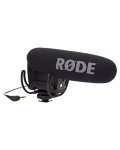Okay, you are going for the least expensive items possible. That implies to me that you have a seriously limited budget.
A little audio info for you...
Having the microphone mounted on top of the camera is one of the worst places you can put it. The optimum position for a (hypercardioid) microphone is in front of and above the actor, aimed at the notch at the base of the throat. Quite obviously this means that you need to put the mic on a boom-pole, which means that you will need a boom-op. Otherwise you are probably going to end up with low levels and/or noisy and/or unintelligible production dialog.
With wireless systems you need both a transmitter and a receiver in addition to the lavalier microphone. When it comes to wireless systems the RODE is a passable ultra-micro budget alternative. I've never even heard of, much less used, Comica products, so I would be dubious as to the quality. BTW, neither comes with a lav, so you'll need to add that to your budget. You will need
AT LEAST two, preferably three (or more), wireless lav systems.
If you give us (me) a
FIRM budget we (I) can help you with putting together a passable production sound kit.
My advice for you is as follows....
1) Read "The Location Sound Bible" by Ric Viers. It's a good place to start for a solid look at production sound history, techniques and equipment.
2) Hire a professional production sound tech, or at least work with a talented, ambitious up-and-comer looking to hone their skills.
3) Do not buy,
RENT the gear you need. Renting will most assuredly get you much better gear than you could buy. A mentor once told me "If you don't use it every day don't buy it." After your shoot the cheap audio gear you purchased will sit in your closet collecting dust and losing what little resale value it may have.
4) If you absolutely
MUST buy gear at least buy quality equipment - at least it will have some resale value.
Just for fun, here's my venerable production sound buyers guide. It's probably up into the $1,750 range now.
Shotgun mic kits will have the shotgun mic, boom-pole, shock-mount and simple wind protection (softie).
http://www.bhphotovideo.com/c/product/551607-REG/Audio_Technica_AT_875_Shotgun_Microphone.html
http://www.bhphotovideo.com/c/product/461493-REG/Rode_NTG_1_Shotgun_Condenser.html
Hypercardioid mic:
http://www.bhphotovideo.com/c/product/867157-REG/Avantone_Pro_CK1_CK_1_Small_Capsule_FET_Pencil.html
My old favorite the SE1a is no longer available. Anything else I like for production sound is in the $500 up range.
Audio recorders:
https://www.bhphotovideo.com/c/product/1086798-REG/tascam_dr_70d_4_channel_audio_recording.html
https://www.bhphotovideo.com/c/product/1084690-REG/tascam_dr_60mkii_portable_recorder_for_dslr.html
Any decent audio recorder with XLR inputs will do the job, but these are "aimed" at indie filmmakers.
Headphones:
http://www.bhphotovideo.com/c/product/49510-REG/Sony_MDR_7506_MDR_7506_Headphone.html
http://www.bhphotovideo.com/c/product/507447-REG/Sennheiser_HD_25_1_II_HD_25_1_II.html
You'll also need cables, cases, battery packs and other miscellaneous items - about $200 to $500.
Your project will only look as good as it sounds, because
"Sound is half of the experience"
If your film looks terrible but has great sound, people might just think it's your aesthetic.
If your film looks great and has bad sound, people will think you're an amateur.
Sound is the first indicator to the industry that you know what you're doing.
 1) RØDE VideoMic Pro Compact Directional On-camera Microphone.
1) RØDE VideoMic Pro Compact Directional On-camera Microphone. 2) RODE Wireless GO - Compact Wireless Microphone System ,WIGO
2) RODE Wireless GO - Compact Wireless Microphone System ,WIGO 3)Lavalier Microphone Wireless,Comica BoomX-D D2 2.4G Lapel Microphone Wireless System.
3)Lavalier Microphone Wireless,Comica BoomX-D D2 2.4G Lapel Microphone Wireless System.

